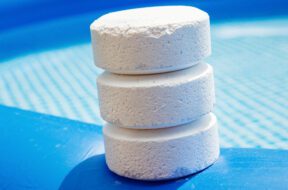
Want to learn more about algaecide? Read on to find out when to add algaecide to your pool maintenance routine and other helpful tips.
Pool enclosures are structures that surround your pool. They are gaining popularity for the benefits they provide, including: privacy and security, protection against debris, and year-long pool enjoyment. In general, there are three types of pool enclosures.
Low pool enclosures are intended to protect your pool while also allowing enough height for you and your guests to swim in the pool. Low enclosures can almost be thought of like pool covers that allow you to still use your pool. They typically fit around the edge of your pool and hang 1 to 3 feet above it.
Mid-Height pool enclosures are intended to protect your pool without obstructing the pool experience for you and your guests. These types of pool enclosures typically range in height from 8 feet to 12 feet, and fit around the concrete surrounding the pool. This allows pool goers to both use the pool and relax by it within the confines of the pool enclosure.
High pool enclosures provide similar benefits as mid-height pool enclosures, but offer more ample space to eliminate any feeling of confinement. These types of pool enclosures are typically 12 feet or higher and fit around the concrete surrounding the pool, similar to mid-height pool enclosures.
Pool enclosures can be a hefty investment, ranging from thousands to tens of thousands of dollars, depending on what type you get. However, the investment can definitely pay off. Here are a few reasons why.
Pool enclosures can provide an added layer of privacy and security to your pool. The simplest of pool enclosures – flat pool enclosures – can be used to prevent trespassers from using your pool when you are not.
Pool enclosures can reduce exposure to harmful UV rays. Pool enclosures can prevent bugs from irritating you and your guests or ending up in your pool. They also prevent debris from vegetation or other things from cluttering your pool.
Some pool enclosures can effectively turn your outdoor pool into an indoor pool and allow you to enjoy your pool all year long. Others provide the best of both worlds and give you the ability to decide whether you want an outdoor or indoor experience on any given day.
The easiest and most affordable type of enclosure to add to your pool is a pool screen enclosure. A pool screen enclosure is made up of a synthetic material, often fiberglass, that encompasses the pool area.
Pool screen enclosures can be used to protect you and your guests from bugs and UV rays, as well as protect your pool from debris. If you have trees or other vegetation near your pool, a pool screen enclosure can be used to prevent twigs, leaves, or other things from falling or blowing into your pool from above.
Similarly, a pool screen enclosure may reduce the amount of bugs and insects you experience around your pool by preventing them from entering through the screen. Pool screen enclosures may also provide added privacy by covering field of view from neighbors or other possible third-party observers.
Glass pool enclosures are typically more expensive than pool screen enclosures. They provide many of the same benefits as pool screen enclosures. They prevent bugs from irritating you and your pool guests, as well as debris from finding its way into your pool. The glass also reduces harmful effects of UV rays, and tinted glass can be used to further reduce these effects.
Glass pool enclosures provide added security. It is easier for trespassers to break through pool screen enclosures than glass pool enclosures. Unlike pool screen enclosures, glass pool enclosures also allow you to use your pool year round. Where as screen enclosures allow outside air in so you may still enjoy the breeze and ambient temperature, glass pool enclosures repel outside air from flowing in and instead allow you to regulate temperature.
Retractable pool enclosures combine several benefits. Retractable pool enclosures allow you to open your pool and enjoy the outside weather and breeze during warm months, while providing the option to continue using your pool during cold months. Many retractable pool enclosures are electric, making it easy to oscillate between an indoor and outdoor pool.
The ease of modern retractable pool enclosures allow you to enjoy the outdoors while using your pool but also protect it from the elements and trespassers when you’re not. Simply retract the pool enclosure when in use, and cover the pool when not in use. From a cost perspective, a low glass retractable pool enclosure may be an appealing alternative to a medium or high pool screen enclosure.
In addition to enclosing your pool, you can also enclose your pool equipment. You don’t want your pool guests to see the unaesthetic tools you use to keep your pool sparkling clean. Pool equipment enclosures provide a stylish, cost-effective way for to store all your pool equipment and keep your pool’s curbside appeal as nice and clean as you keep your pool, itself.

Want to learn more about algaecide? Read on to find out when to add algaecide to your pool maintenance routine and other helpful tips.

In this quick guide, we’ll answer the question “can you over shock a pool” and unveil the factors to consider when shocking a pool.

Maintaining both pH and total alkalinity in your swimming pool is important for keeping your pool properly sanitized and non-corrosive. Total alkalinity is to pH what cyanuric acid is to free chlorine. Total alkalinity stabilizes pH levels. The ideal pool pH level is 7.4 to 7.6. The ideal total alkalinity level is 80 to 120 ppm.

The Association of Pool and Spa Professionals recommends free chlorine levels for both swimming pools and hot tubs be kept between 2.0 and 4.0 ppm. However, the Center for Disease Control recommends free chlorine stay above 1 ppm in pools and 3 ppm in hot tubs.